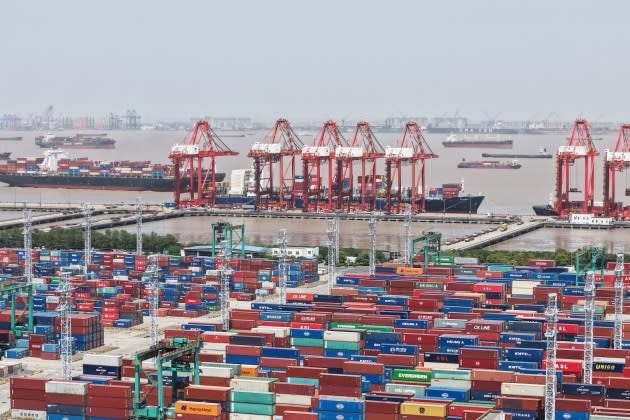3Dolls4You.com
Is 3 too little? Are 30 too many? Who's to say? I guess that's what the future is for.

Three Dolls and the Cost of War: A Call to Shared Sacrifice
The prison yard is a cold stage, bets traded in whispers, shadows clotting like old blood. In the center, a man stands, right side to the crowd, eyes like a switchblade. No push-ups today—the hustle’s bigger, a desperate game with the Pacific as the table. Trump’s voice slices the air: “Maybe three dolls, not 30.” It’s not about toys—it’s a call to sacrifice, a grim reveille for a nation edging toward a war footing. The trade numbers are a gut-punch: in 2012, U.S.-China trade hit $579 billion, with a $298 billion deficit favoring China. By 2024, the goods deficit was $293 billion, and 2025’s March data shows a $17.93 billion monthly gap, the chasm holding firm. Our hunger for their goods feeds their grip on our future.
I wrote about “The Sandbag Hustle” in this piece, and how it impacted my life in prison as a convicted felon. It should be noted that while I may never share the status of the office of President with Trump, I do share the title of felon with him.
Trump’s Long Game: Tariffs as Authenticity
Trump’s “three dolls” line isn’t a sound bite—it’s a thread from the 1980s. In a 1987 CNN interview, he blasted Japan’s trade surplus, growling, “We’re being ripped off… we have to get tough.” In 1990, on The Phil Donahue Show, he called out foreign competitors for “killing us” with unfair deals, pushing tariffs to protect workers. By 1999, on Meet the Press, he warned America was “losing billions” to bad trade. His 2000 book, The America We Deserve, doubled down on “strategic tariffs.” This wasn’t a flip—it was a builder’s blunt math, honed in New York’s dog-eat-dog markets. In 2025, with 145% tariffs on Chinese goods, he’s not chasing votes—he’s fighting a war he’s waged since hair bands and walkmans.
That consistency is Trump’s brand: raw, unfiltered authenticity. To the working class—Rust Belt welders, Carolina textile hands, Gulf of America shrimpers, New York firemen, Kansas farmers, High Plains drifters, Bronx diner cooks, Philly cops, Detroit car builders, Idaho preppers, Cali dreamers—he’s the guy who’s never changed his tune: America’s getting screwed, and tariffs are the hammer. A 2025 Rasmussen poll shows 62% of blue-collar voters trust him on trade, not because he’s polished, but because he’s real. He’s the barstool preacher, same sermon for 40 years, and that pulls the yard’s crowd to his corner.
I keep banging the drum, and people keep prattlin on bout “conventional wisdom” and “incumbents in power, blah, blah blah”, and “the midterms yada yada” and losin the point that those days are over. Why did Kodak have 145,000 workers in the 1980s and none in the 2000s?
China’s Commercial Stranglehold
This fight isn’t talk—it’s survival. China’s commercial dominance is a blade at our throat, sharpest in merchant shipping. In 2024, they built 53% of global commercial vessels, over 42 million gross tons, while U.S. shipyards limped at 0.5 million. COSCO Shipping, Beijing’s state-backed titan, runs 1,400 vessels; our 178 active merchant ships are rusting shells. China flags 6,000 vessels; our 1,700 are pathetic. A 2025 Maritime Administration report warns our sealift would choke in a Pacific war—China’s ports live, ours die.
Lithium batteries are another vise. China produces 79% of global lithium-ion batteries, controlling 73% of cathode and anode materials. EVs, grid storage—they own it, while U.S. output stalls at 7%. Their 92% grip on rare earths starves our supply chain. Drones? China’s DJI holds 77% of the global market, from hobbyist toys to battlefield UAVs. U.S. drone tech, underfunded and scattered, can’t compete. In a war, their drones dominate; ours get shot down.
China’s shadow stretches further. They supply 42% of U.S. pharmaceutical ingredients, a kill-switch for our hospitals. They hold $590 billion in U.S. debt, a leash they tug at will. Chinese firms own 437,000 acres of U.S. farmland, some near bases, sparking Pentagon scrutiny. Fentanyl, tied to Chinese precursors, killed 1,500 U.S. service members and 370,000 civilians aged 18–45 since 2020, gutting our draft pool. Meanwhile, 35,000 Chinese men crossed our borders illegally, some flagged as risks. The yard whispers: chance or design?
A Brief History of American Consumerism
A century ago, America was lean. The 1900s meant sustenance—flour, cloth, tools. The Depression and World War II forged thrift, with ration cards and victory gardens. Post-war booms flipped it: the 1950s brought suburbs, TVs, and ads pitching desire. By the 1980s, malls were cathedrals, credit cards gospel. China’s cheap goods flooded in; we piled up 30 dolls when one sufficed. In 1960, consumer spending was 60% of GDP; by 2024, it’s 68.2%, a nation of buyers, not builders, hooked on imports, unable to self-suffice.
The Fall of American TVs: From Dominance to Dust
The arc of the TV in America is a tombstone for our manufacturing might. In the 1950s, we owned the game—RCA, Zenith, and Motorola churned out boxy sets in U.S. factories, employing tens of thousands. By 1955, 70% of American households had a TV, most stamped “Made in the USA.” RCA’s Indianapolis plant alone produced 2 million sets a year, a humming symbol of postwar pride. We didn’t just build TVs; we built the culture—The Lone Ranger flickered on screens we made ourselves.
The 1970s brought cracks. Japan’s Sony and Panasonic undercut us with cheaper, better tech, like the Trinitron tube. U.S. firms, bloated and slow, couldn’t keep up. By 1980, Japan held 40% of the U.S. market; our share crumbled. Then came globalization’s gut-punch: the 1990s saw production shift to Mexico and Asia, chasing low wages. Zenith, the last U.S. holdout, sold to South Korea’s LG in 1995, and their Chicago factory shuttered. By 2000, U.S. TV manufacturing was a ghost—99% of sets were imported.
I get it! I loved my walkman and my 12 cassettes for a penny. But guess what, hidden costs and unintended (oh they were intended) consequences shaped an entire generation to the art of sandbag, short-change, and scam.
For Gen X, Trump’s 54% tariffs in 2025 feel like a long-overdue reckoning, a lived-experience reaction to decades of exploitation epitomized by scams like Columbia House. Growing up in the ‘80s and ‘90s, we bit the bait of 8 cassettes for a penny, only to be ensnared by Sony’s predatory “negative option billing,” racking up bills for unwanted albums while the Japanese giant, alongside Time Warner, pocketed billions. This betrayal, coupled with watching U.S. industries like Kodak crumble after passing over visionaries like Phil Samper for traditionalists like Kay Whitmore, seared a distrust of foreign profiteers into a generational psyche—tariffs now strike as a visceral middle finger to that exploitation, a chance to reclaim jobs and pride lost to cheap imports and corporate greed.
Open Letter to Gen X: #5 - Identity and Intersection
My Friends, Substack is awesome! My posts have a new structure, and will have some new features, sections, and other surprises. Surprises because even I don’t know what they are yet! Keep scrolling d…
China sealed the coffin. By 2010, brands like TCL and Hisense, backed by state subsidies, dominated. In 2024, China produced 70% of global TVs, with TCL alone shipping 25 million units. The U.S.? We assemble a few high-end models, but the last full TV factory closed in 2004. A 2025 Consumer Reports survey found 85% of TVs in American homes are foreign-made, mostly Chinese. We invented the industry, but we sold it for cheap screens—now we’re left with nothing but the remote.
American Industries Sold for Convenience
TVs were just the start—a parade of American-invented industries we traded for convenience. Radios? We birthed the industry with the 1920s radio boom—RCA and Philco made the U.S. the world’s radio hub, with 80% of global production by 1930. By the 1980s, Japan’s transistor tech and cheaper labor gutted us; now, China produces 90% of radios, per 2024 trade data. Appliances followed the same arc: General Electric and Whirlpool defined the 1950s American kitchen—refrigerators, washers, all U.S.-made. By 2000, 70% of small appliances were imported, and in 2024, China controls 60% of the global market for fridges and stoves, per Statista.
Cameras, too—we invented the mass market with Kodak’s 1900 Brownie, putting photography in every home. Kodak employed 145,000 at its 1980s peak, but Japan’s Canon and Nikon outpaced us with digital tech. By 2010, Kodak was bankrupt; now, China’s DJI and others dominate camera tech, holding 65% of the market in 2024. Add textiles—Levi’s jeans, born in America, now mostly sewn in Asia—and furniture, where 70% of U.S.-sold pieces are imported, per 2025 Census data. We pioneered these industries, then sold them for cheap goods, leaving empty factories and broken towns.
Kodak’s 1989 CEO blunder—choosing Kay Whitmore over Phil Samper—mirrors today’s U.S. industrial gamble with chilling precision. Whitmore’s cling to film profits, ignoring Samper’s digital foresight, let Kodak rot as the digital wave crashed in. Now, with China’s 53% grip on global shipbuilding and 79% on lithium batteries in 2025, our leaders risk the same myopia, betting on service-sector comfort while manufacturing crumbles—trading 30 dolls for three, but without the guns to back it up.
Samper, passed over, didn’t fade—he founded ViewStar Corporation, pioneering document imaging, and later led Autodesk, driving 3D design innovation, proving his vision could’ve saved Kodak. His trajectory screams a lesson: sidelining forward-thinkers for tradition-bound suits leaves us vulnerable, just as Kodak’s bankruptcy in 2012 haunts us. Today’s tariffs and reshoring pushes—like Liberty Tabletop and Allegiance Flag—need leaders like Samper, not relics, to outmaneuver China’s industrial juggernaut.
This isn’t ancient history; it’s a warning flare. Kodak’s collapse shows how a single bad call can gut a giant, and with fentanyl killing 370,000 Americans aged 18–45 since 2020 and our war readiness teetering at six weeks, we can’t afford another misstep. The yard’s betting on unity and grit—look to Samper’s legacy and ditch the old guard, or we’re staring at our own 2012, with no second act.
Think about the most recent monthly job numbers, widely lauded at 170,000 jobs added, in the context of one company’s workforce at its peak - Kodak’s 145,000. That’s just four decades ago, when most Gen-Xrs were teenagers. So in a single lifetime, not just the labor force of America has changed, how we think about it has shifted even more.

The War Footing
Trump’s “three dolls” is a flare, echoing 1940s calls to ration for victory. Today, it’s about reviving factories, securing supplies, and facing truth. Our war readiness is thin. China’s navy, 380 ships, dwarfs our 290. Their shipbuilding is 230 times ours; their missiles and hypersonics outpace us. A 2025 wargame projects six to eight weeks of U.S. ammo and ships in a Taiwan fight, then collapse.
Yet, small victories show the way. Liberty Tabletop, the only U.S.-made flatware company, stands as a beacon. Based in Sherrill, New York, it crafts 18/10 stainless steel flatware with American steel, employing 50 workers and preserving a century-old craft. Allegiance Flag Company, another American holdout, stitches 100% U.S.-made flags in South Carolina, using domestic materials to wave defiance at foreign imports. Red Land Cotton is another go-to American company.
These aren’t just products—they’re proof we can claw back manufacturing, job by job, if we choose sacrifice over indulgence. Buying from Liberty, Red Land, or Allegiance isn’t just a purchase; it’s a vote for the factories we need to survive a war.
America’s military-aged population, particularly those 18–45, is facing a crisis that could cripple its war readiness, with over 370,000 deaths from fentanyl—much of it traced to Chinese precursors—since 2020, decimating the prime draft pool. This silent war has left a generation physically hollowed out, with addiction and overdose eroding the health and resilience needed for combat. A 2025 CDC report highlights a surge in chronic health issues among survivors, including liver damage and respiratory decline, while obesity rates, already at 42% nationally, further thin the ranks of those fit for service—only 23% of 17–24-year-olds met enlistment standards in a recent Pentagon study, down from 29% a decade ago.
This physical unfitness amplifies the grim forecast of a six-to-eight-week limit in a kinetic war with China, where their 380-ship navy and 230-times-greater shipbuilding capacity dwarf our 290 vessels. The loss of this cohort, coupled with 35,000 Chinese men crossing U.S. borders illegally since 2020—some flagged as risks—creates a dual threat: a weakened defense and a potential fifth column. Trump’s tariffs and calls for sacrifice, like supporting sacrifice and purpose, aim to rebuild industry, but without a healthy, able-bodied force, the yard’s bet on resilience falters. The raw truth is stark—America’s military future hinges on reviving not just factories, but the bodies and spirits of its youth, or we’re outgunned before the first shot.
The bad news: we’re unready. Our services economy—71% of GDP—can’t pivot fast. China’s industrial might, fed by our indulgence, holds the edge. Sacrifice can shift it: reshore factories, seal borders, break China’s chokehold. Trump’s tariffs sting, but they force the question: can we endure to rebuild? The yard’s watching, clock ticking.
The Working-Class Answer
In the yard, a Black cop and a white plumber stand shoulder to shoulder, their calloused hands and shared gripes louder than their differences. They’ve got more in common with each other than either does with a college-educated suit—any color, any coast. The cop’s seen the streets bleed from fentanyl; the plumber’s seen jobs vanish to cheap imports. Both know the elite’s promises are hollow, their degrees a wall, not a bridge. This bond, forged in sweat and struggle, is the answer civil rights giants like King dreamed of—not division, but unity in shared fight.
Yet, this working-class alliance is dynamite to the Democratic Party’s old base. Grievance politics, built on slicing the electorate by race and resentment, crumbles when black, white, yellow, red, purple, and brown workers lock arms. The left’s call for justice rings true, but their playbook—pitting groups against each other—dies in the face of this natural coalition. A 2025 YouGov poll shows 58% of working-class voters, across races, prioritize economic fairness over identity politics. The yard’s not blind: unity is power, and it’s rewriting the game.
Business Thinking as the Fix
The collapse of industries like TVs, radios, and cameras wasn’t just globalization—it was paralysis. American firms, bloated with bureaucracy, couldn’t pivot in real-time to Japan’s tech or China’s scale. RCA, Kodak, and GE dithered while competitors innovated, their boardrooms mired in red tape, unable to match the speed of markets. That same sluggishness haunts government, a beast too slow to adapt. Trump’s long championed business thinking as the antidote—lean, decisive, results-driven. Since the 1980s, he’s argued government needs to move like a builder: spot the problem, act fast, fix it. His 1987 book The Art of the Deal laid it bare: “You can’t con people, at least not for long… you have to deliver.” For Trump, Washington’s failure to deliver isn’t ideology—it’s incompetence.
Take the 2025 air traffic controller crisis, a glaring symbol of government’s ineptitude. The FAA’s systems, running on 1980s software and crumbling hardware, have triggered chaos: 15,000 flight delays in March alone, per FlightAware data, with controllers using paper strips in some towers because digital upgrades failed. A 2025 GAO report flagged $5 billion in cost overruns for the NextGen program, meant to modernize air traffic control, but mired in delays and tech glitches. Airlines lost $2 billion in Q1 2025 from cancellations, and passengers are stranded daily. The government’s response? More committees, more studies, no fixes. Trump’s answer, echoed in a 2025 Truth Social post, is straight business logic: “Fire the bureaucrats, hire the tech guys, get it done—yesterday.” His push for private-sector efficiency—streamlined, accountable, fast—clashes with a system that can’t keep planes in the sky, let alone win a war.
Let’s reframe the concept of the “sacrifice” narrative, moving away from the idea of giving up the excess of 30 dolls and instead exploring it as a deliberate shift from luxury-driven consumption to securing essential needs. Traditionally, “sacrifice” evokes relinquishing comforts—fewer toys, less indulgence—but in this context, it’s less about luxury and more about redirecting resources to meet actual needs: a robust manufacturing base, secure borders, and a healthy military-aged population. It’s not about denying the boy his toy guns or the girl her dolls; it’s about ensuring those toys are American-made, like Liberty Tabletop’s flatware or Allegiance Flag Company’s flags, and that the hands holding them are strong enough to fight. This redefinition aligns with Trump’s tariff push not as a loss, but as an investment in survival, turning the yard’s hustle into a strategic rebuild.
Rethinking sacrifice this way strips it of its punitive tone and casts it as a pragmatic choice, echoing the WWII-era shift from consumer excess to victory gardens. With 370,000 military-aged Americans lost to fentanyl since 2020 and only 23% of 17–24-year-olds fit for service in 2025, the need isn’t for fewer dolls but for a nation that can sustain itself—pharmaceutical independence from China’s 42% grip, farmland security from their 437,000 acres, and industrial might to counter their 53% shipbuilding edge. Sacrifice here means prioritizing essentials—jobs, health, readiness—over the imported luxuries that fueled our 68.2% consumer GDP in 2024. It’s a call to the Black cop and white plumber to unite not just in shared struggle, but in building a foundation where their kids inherit strength, not debt, making the vision a gritty promise rather than a grim trade-off.
This is the stakes: a government too slow to act, industries too rigid to survive, and a nation on the brink. Trump’s tariffs, his call for three dolls, his demand for business thinking—they’re all the same fight. Can we move fast enough to rebuild, to unite, to endure? The yard’s watching, and the dealer’s impatient.
Resist what you want, but your needs will outweigh your desires in short time.
I stand ready,
Ric









Thought provoking read.
I like the playlist.
In the fall 2021 we were shopping for a 20 foot sea train for storage on our ranch. We found several in the price range of $1000-$2000. They were very inexpensive because China makes the shipping containers and sends them full to the United States, where they are unloaded and then left in America as the empty ships our sail back to China. Because there is nothing we send to China. Our very little.
We hesitated on the purchase because we really wanted to see our product before we bought it, and it was impossible to actually see the sea train you wanted to purchase. So he waited too long and then right after Biden was elected president the price of them skyrocketed to about $4000 for a 20 footer. I still don’t know what went on.